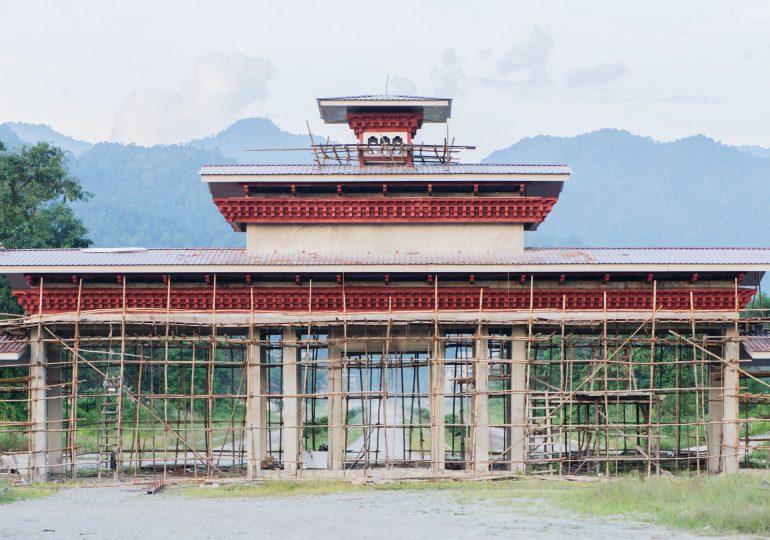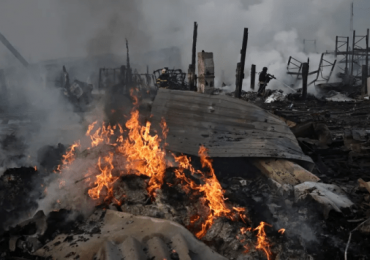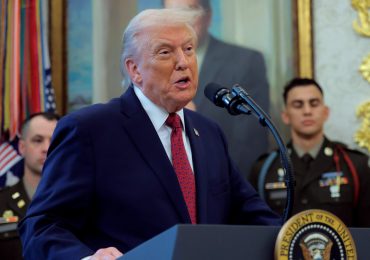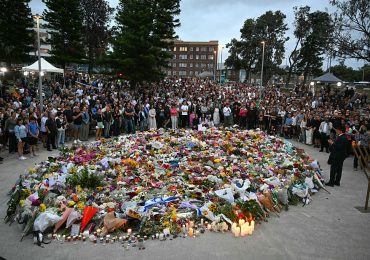The drive up to Phulari viewpoint snakes for three miles along dirt tracks flanked by flowering pyoli plants and murals of flaming phalluses, a traditional good-luck symbol here in the Himalayan Kingdom of Bhutan. At the summit, the 1,000-sq.-mi. expanse of what will be Gelephu Mindfulness City (GMC) materializes through fluttering prayer flags. To the east, a strip of palm forest has been cleared to extend the domestic airport’s stunted runway for international flights. To the west, smoke billows from the chimney of an army-run distillery. Over the horizon lies the Indian state of Assam, where much of the labor and materials to construct the $100 billion new special administrative region will come from.
[time-brightcove not-tgx=”true”]
“Activity at the site is just beginning,” says Dr. Lotay Tshering, a urologist who served as Bhutan’s Prime Minister from 2018 to 2023 and is now governor of the GMC. “But progress in the designing phase—planning, negotiations, discussions, exchange of ideas—is happening beyond our expectations.”
Those expectations are nothing less than putting a smile back on the self-styled “happiest place on earth.” In December 2023, Bhutan’s King Jigme Khesar Namgyel Wangchuck announced the GMC as part of “wholesale” reforms of the nation’s economy to combat challenges such as 29% youth unemployment and a resultant brain drain of talent overseas. In 2023, some 1.5% of the population moved to work and study in Australia alone. Meanwhile, the birth rate has dipped to just 1.4 children per woman, portending a shrinking, aging populace. Compounding matters, tourism, one of the principal revenue sources in this nation of 785,000, was brought to a standstill by the pandemic and still hasn’t fully recovered, with just a third as many foreign arrivals in 2023 compared with 2019. One in 8 Bhutanese lives in poverty.
It’s a crisis that has sparked sweeping changes to uplift the world’s literally loftiest country. In 2023, Bhutan’s government halved its daily tourist levy to just $100 to boost flagging arrivals. One-year national service has been introduced to ensure all 18-year-olds receive military and vocational training—including, in a nod to the brain drain, for Bhutanese youth based overseas. Special funds have been introduced to spur innovation and entrepreneurship. But the Land of the Thunder Dragon—so named for the vicious storms that crash through its furrowed highlands—aims not to simply embrace capitalism but to redefine it for the modern, sustainability-focused era.
To wit: the GMC. Three times as large as Singapore, with a projected cost equivalent to 30 times national GDP, it aims to attract foreign companies willing to engage in “mindful capitalism”—focusing not just on pure profit but also on ecological harmony and spiritual contentment. Artists’ renderings depict a low-rise metropolis built around a network of inhabitable timber bridges, each boasting key features: a university, a hospital, a hydroponic greenhouse, a cultural center, a spiritual center, an organic market. The site will be sprinkled with pristine wildlife sanctuaries, farms, rice terraces, and temples. All vehicles will be electric, single-use plastics banished. Green power would be provided by a hydroelectric dam complete with an elevated temple in its mosaic facade. Applicants will be carefully vetted and permitted to set up only by special invitation.
“Happiness and well-being of people must be the purpose of capitalism,” Bhutan Prime Minister Tshering Tobgay tells TIME. “We are talking about creating a new paradigm, an entirely new system of urban development.”
It’s an undeniably utopian vision for a landlocked nation half the size of South Carolina whose economy ranks 177th in the world (between Curaçao and Burundi). But Bhutan has long played by its own rules. It was an absolute monarchy until 2006, when King Jigme Singye, father to the current monarch, unilaterally chose to devolve power to a parliamentary democracy. (Elections were held two years later.) It is fiercely protective of its unique culture, allowing only local films in cinemas, insisting on national dress in government offices and schools, and having diplomatic relations with just 54 nations. While most developing nations focus on GDP growth, in the late 1970s Bhutan’s ruling monarch decided “gross national happiness [GNH] is more important”—championing a holistic approach toward development that placed equal weight on sustainability, spirituality, and ecological harmony. The GMC, says Tobgay, is “gross national happiness 2.0. We’ve applied GNH throughout the country. It has worked. But how do we apply GNH in a modern urban environment?”
Despite the nation’s meager economy, all Bhutanese receive free education and health care. Over 70% of territory is forested with a constitutional mandate to never be below 60%. It’s the world’s first carbon-negative country, and Tobgay insists the GMC will be the first carbon-negative city. But melding such salutary principles with capitalism risks their being deleteriously diluted.
“Given that South Asia so lacks even the most basic forms of infrastructure, for Bhutan to be launching this massive project beggars belief that it could really be as successful as they would like it to be,” says Michael Kugelman, director of the South Asia Institute at the Wilson Center.
Such a transformative influx of foreign cash also risks seeding new power centers and patronage networks that could drastically shift the political equilibrium in one of the world’s youngest democracies—not least given that Bhutan sits sandwiched between Asian super-powers India and China. But at a more fundamental level, will large multi-nationals and their employees want to move to a patch of the Himalayan foothills with scant regional connections?
“The first phase is about bringing the common minimum infrastructure for investors to gain confidence,” says Lotay, speaking to TIME over momo dumplings and ema datshi, Bhutan’s national dish of chilies cooked in melted cheese. “We really need not rush.”
If anywhere can rip up capitalism’s shibboleths, it’s Bhutan. This Shangri-la hidden in the folds of the Himalayas was a pugilistic hodgepodge of Buddhist fiefs until unification as a nation in the 17th century. Since then, Bhutan has thrived by shunning outside influence. This is a country where belief in yetis is so pervasive that a national park has been dedicated for their protection. The patron saint is a 15th century monk called Drukpa Kunley, better known as the Divine Madman, who marauded the countryside with his bow and faithful hunting dog, while drinking copiously, seducing thousands of women—including his own mother—and subduing demons with his penis, which he dubbed the Flaming Sword of Wisdom. (Hence the murals.) The nation deftly eluded European colonization and managed to sit out both the Industrial Revolution and two World Wars.
Measuring just 200 miles from east to west and half that from north to south, Bhutan rooted survival in keeping at once low and aloof in an unruly neighborhood.
But Red China’s conquest of neighboring Tibet shifted that calculus. “Great Helmsman” Mao Zedong considered Tibet a palm whose “five fingers” of Ladakh, Nepal, Sikkim, Bhutan, and the British Raj’s North-East Frontier Agency (today India’s Arunachal Pradesh province) also fell under Chinese suzerainty. Against this backdrop, Bhutan moved closer to New Delhi under Indian Prime Minister Jawaharlal Nehru, who sought a bulwark against creeping communism by offering his tiny neighbor security guarantees.
Still, internally, things barely budged. In 1961, the same year that the USSR sent the first human into space, Bhutan got its first paved road. It remained closed to tourists for another decade and officially had no television until 1999 (though bootlegged satellite dishes and videos showing Bollywood movies and soap operas were already commonplace).
Today, India remains the dominant influence. As Bhutan declines to have diplomatic relations with any U.N. Security Council member, it has no official ties with regional superpower China, nor the U.S. Bhutan’s ngultrum currency is pegged to Indian rupees and used interchangeably. Bhutan is the single largest recipient of Indian aid, pocketing $240 million in 2024. Some 85% of goods sold in the country are imported by the Indian Tata trucks adorned with jaunty faces that hurtle down twisting mountain roads to remote villages.
While the rest of the globe frantically fetishized growth targets, Bhutan shunned opportunities to monetize its considerable natural resources—including lumber, coal, and minerals—that would have come at the expense of the environment. The guiding philosophy melds the Buddhist principles of karma—cause and effect; that bad deeds will be repaid in kind—with Bon animism, which teaches respect for all sentient beings. The combination venerates the natural world more than arguably any other culture.
But Bhutan’s skepticism regarding industry doesn’t extend to technology. Today, most urban areas enjoy decent 5G coverage. At Pochu Dumra Buddhist School in Bhutan’s ancient capital of Punakha, dozens of novice monks lounge on a manicured lawn, playing bamboo flutes, chanting sutras, and weaving tantric ornaments from brightly hued string. On the second floor sits an IT study where saffron-robed students ages 13 to 17 spend an hour each day glued to Dell desktops and Samsung tablets to learn word processing, spreadsheets, and how to conduct research discerningly via the Internet. “When they become teachers, lamas, and administer their own monastery, they need to keep records of their administrations,” says English and IT teacher Thinley Jamtsho, 31. “It’s important for the development of the country.”
The recent explosion of green technology means Bhutan no longer has to sacrifice its karmic principles to get ahead. Today, Bhutan has 2.5 GW of installed hydropower, half of which is sold to India. Instead of creating huge reservoirs to dam the rivers and compromise their delicate ecology, Bhutanese turbines harness their natural flow, meaning a glut of power during the sodden summers and a dearth during the parched winters. To equalize this, excess summer hydropower is harnessed to mine green bitcoins that are cashed in to buy back electricity from India when rivers are driest. “Bitcoin functions strategically as a battery,” says Ujjwal Deep Dahal, CEO of Druk Investments and Holdings, Bhutan’s $4 billion sovereign wealth fund, whose stated goal is to grow tenfold by 2030. “And every bitcoin in Bhutan offsets that much mined globally through a coal plant.”
Abundant hydropower is clearly one of the GMC’s core strengths. Bhutan has total hydropower potential of around 35 GW with the aim to harness 15 GW by 2040, making the hosting of energy-hungry AI data centers a real possibility. Another perk Bhutan enjoys is a comparatively well-educated, English-speaking population—in turn, a key driver of the brain drain. “We are the victims of our own success,” says Togbay. “All our youth have been to school and can get jobs anywhere in the English-speaking world.”
It’s clear the GMC is meant to provide incentive to stay. Lotay says it will be “second to none.” Famed Danish architect Bjarke Ingels has been tapped to draw up the master plan, the airport extension is being designed by a renowned Dutch firm, the economic plan overseen by an Australian consultancy, the environmental-impact assessment by a top multinational. The GMC will also be uniquely self-governing. Judicial, legislative, and executive authority have all been devolved to a board chaired by King Jigme but composed of “the best of the best” in their fields regardless of nationality, says Lotay. “We can have our own tax regimes, tourism policy, visas, startup ecosystem. It’s almost like the GMC is a country but governed by people from around the world.”
It will also have its own digital currency, the ter, which will be secured by blockchain and backed by gold, as well as Asia’s first (and one of only a handful anywhere in the world) full reserve digital bank, dubbed Oro Bank. While most banks keep a tiny fraction of deposits in reserve and invest or lend out the bulk to earn a profit, this risks default and potential bankruptcy should creditors withdraw en masse. (A total of 568 American banks failed from 2001 through 2024, including most notoriously Silicon Valley Bank in March 2023.) By contrast, Oro Bank will keep all its customers’ deposits in reserve, rendering failure virtually impossible, and instead earn money via premium services and dedicated investment accounts. “It’s a digital vault,” says Oro Bank CEO Mike Kayamori. “We don’t need to pursue capitalism at its extreme. But if it’s done well, and it’s going to take time, I believe we can become the largest bank in the world.”
Oro Bank, like the GMC writ large, is betting on investors putting long-term stability above short-term gain. For one thing, because GMC was established by royal decree, it’s effectively immune to the vicissitudes of party politics. “Here your business partner is His Majesty the King,” says Lotay. “Once you start doing business, you have no worries for the next 30, 40, 50 years.”
Still, critics say royal patronage comes with a darker side. The GMC is set to occupy 2.5% of Bhutan’s total landmass, which is currently inhabited by some 10,000 people, mostly farmers, who already rate the lowest in Bhutan’s GNH surveys, with only 33% classified as happy in 2015. Residents fear they could be evicted with little compensation, says Ram Karki, an exiled Bhutanese human-rights activist based in the Netherlands. (Tobgay insists “forcing people to leave does not cross our minds. We need people to live there.”) Karki also says that royal backing of the GMC means any criticism could be considered seditious. “To speak anything against GMC is going against the King,” he says. “So people cannot speak.”
It’s clear that Bhutan’s economic opening threatens India’s influence. Asked about the prospect of Chinese investment, Lotay replies that “the GMC will have absolutely no exclusion criteria.” Indeed, Beijing has repeatedly voiced its intent to normalize relations, and the prospect of a growing Chinese footprint in Bhutan has New Delhi “crapping themselves,” one former top Bhutanese official tells TIME. Lotay, however, sees things differently. “I absolutely don’t see any issues,” he says. “While India and China have their differences, they leave us undisturbed.”
The big challenge for Bhutan will be to nod in both directions. For years, nearby Nepal has found itself similarly squeezed and has exploited the situation with varying success. In 2015, India triggered an economic and humanitarian crisis in Nepal by imposing an unofficial six-month blockade, partly sparked by Kathmandu’s warming ties with Beijing, including its purchase of Chinese weaponry. Since then, Nepal has eked concessions from both sides, and today India and China vie to be its top source of foreign direct investment.
Bhutan has not been immune to similar pressure. In 2013, prices of kerosene and cooking gas doubled in Bhutan after New Delhi withdrew subsidized supplies. The spark was then Prime Minister Jigme Thinley’s meeting with Chinese Premier Wen Jiabao on the sidelines of a U.N. sustainability summit in Rio de Janeiro, along with Bhutan’s purchase of 20 buses from China. “China has been really growing its presence and building more influence across the entire region, including in spaces where India has traditionally been not only the main but the only external actor,” says Kugelman.
Improved ties with China certainly have the support of Bhutan’s youth, given the bevy of scholarships Beijing doles out to nations in its orbit, including Nepal, as part of its soft-power push. Kuendhen Wangyel, 20, from Thimphu, is about to travel to Brisbane, Australia, to study architecture at the Queensland University of Technology, which is set to cost more than $65,000 for the three-year tuition. He estimates that around a third of his graduating class are going overseas for college and that many would jump at the chance to attend Chinese universities. “China would be a great opportunity,” he says. “You could learn Mandarin, and nearly all trade comes from China.”
Already, China has built gleaming roads to its shared border with Bhutan, and Lotay insists the eventual normalization of relations is inevitable. But uncertainty remains about how Bhutan can insulate itself from any costs incurred given how dependent its economy is on Indian largesse. Perched on India’s border, the GMC is seen as both an opportunity and warning to New Delhi that if it won’t help Bhutan develop, there are others that will. “You can’t see the city primarily from the angle of Bhutan,” says Rishi Gupta, assistant director at the Asia Society Policy Institute in New Delhi. “It also needs a prism of India benefiting.”
But it’s unclear what industries will be suited. Lotay shrugs that “no sector has already been clearly identified,” though he admits a “conventional manufacturing-based economy does not make sense,” given the tremendous competitive advantage held by Bhutan’s northern and southern neighbors. Bhutan’s main exports include fruit, betel nut, and boulders for construction.
Agribusiness is one possibility. A wedge that begins at snow-capped 7,500 m (around 25,000 ft.) but descends to a smidgen above sea level, Bhutan boasts every conceivable climate, from northern glacial peaks to temperate, fruit-growing valleys and a subtropical south. Within these three physiographical zones are 5,603 plant species, including 369 varieties of orchid and 46 of rhododendron, and more than 480 varieties of edible mushrooms. Of the recorded plant species, 105 are found nowhere else, leading Tibetans to dub Bhutan Lho Menjong, or the Southland of Medicinal Herbs.
But in these digital times, geography need not be a factor at all. Plans are under way for a GMC e-residence program mirroring a scheme pioneered by Estonia in 2014 and now offered by more than 10 legal jurisdictions worldwide. “If you’re a startup in Argentina or India, we will love these businesses to register in GMC and open an account with us,” says Kayamori of Oro Bank.
One year on from the GMC’s unveiling, expectation is being clouded by impatience. Today, the only major building work under way is for a campus to house recruits for the new national-service scheme. Hundreds of workers from the Indian city of Cooch Behar lug steel girders into the concrete shells of what will be dormitories, as a leaf blower removes detritus from an artificial-turf soccer pitch. But construction was already under way before the GMC was announced, only for the government to pause the work, thinking the premises could be repurposed for something grander. When no firm alternatives emerged, and with the site growing mildewed and dilapidated, the original construction resumed.
“By now,” Lotay says, his constituents “are expecting a lot of noise, dust, a few thousand trucks and excavators, and international flights. That’s coming, but it cannot happen overnight.”
Still, ambition is infectious, and despite glacial progress the GMC serves as a beacon to convince young Bhutanese that there are opportunities to prosper at home. Dhechen Chodron set up D-Chens Atelier after graduating in fashion design and marketing in Malaysia. The 32-year-old has developed a wide following by marrying traditional Bhutanese materials with contemporary couture design, dressing everyone from Miss Bhutan to the royal princesses as well as tourists from North America and Europe. She currently occupies a government startup incubator in the capital, Thumphu, where walls are garlanded with sketches and fabric scraps and her subsidized rent is just $50 per month.
“I get most of my customers from Instagram,” Dhechen says, fiddling with an embroidered silky gown that a Bollywood star ordered for the premiere of her latest film. “I’m also very excited for the GMC. Maybe we can get a chance to showcase our designs and collaborate with outside designers.”
On Jan. 24, Ed Sheeran will become the first Western pop star to hold a concert in Bhutan at Thimphu’s Changlimithang Stadium. Prime Minister Togbay says the hope is not only to attract a stream of pop stars but also “more artists, more Nobel laureates, and more thought leaders and business leaders, leaders in social work, philanthropists.”
But however careful the planning, cash has a way of forging its own reality. Although Bhutan officially banned plastic bags in 1999, they’re ubiquitous at Thimphu’s weekend market, containing everything from foraged tea leaves to dried persimmon slices. Meanwhile, roadside trash is a worsening blight. Tourists in the historic city of Paro increasingly complain of price gouging by local taxi drivers. Dahal of Druk Investments and Holdings admits Bhutan will need to build reservoir dams to maximize its hydropower potential, alarming environmentalists already worried about how the GMC will affect Bhutan’s endangered monkeys, tigers, rhinoceros, blue sheep, and snow leopards.
That development begets compromises is no surprise; the question is how negative corollaries can be mitigated. On the roof of the world, an enchanted kingdom of yetis and mystics is preparing to meet the modern world. But can Bhutan really remake capitalism? Or will capitalism break Bhutan?
Leave a comment







